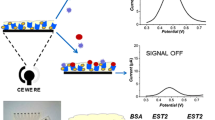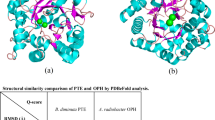Abstract
Organophosphorus hydrolase (OPH; EC 3.1.8.1) is known to be capable of hydrolyzing a variety of organophosphorus compounds, such as sarin and paraoxon. We have developed a nerve agent decontamination method using OPH. The gene that encodes OPH was cloned from the bacterial strain Sphingobium fuliginis ATCC 27551, and several OPH gene fusion plasmids were constructed. Escherichia coli was utilized as the expression host for the resulting plasmids. The activities of the recombinant OPH enzymes expressed (KGU0060, KGU0092, and KGU0094) were determined by measuring paraoxon hydrolysis activities. The recombinant OPH enzymes that lacked the signal peptide regions (KGU0092 and KGU0094) were remarkably activated by zinc ion; while the OPH enzyme that contained the signal peptide region (KGU0060) was activated by both zinc and cobalt ions, although the specific activity of this enzyme was much lower than that of KGU0092 or KGU0094. The pH profile demonstrated that the OPH enzymes effectively hydrolyzed the substrate under alkaline conditions. We applied the recombinant OPH to the degradation of nerve agents; it hydrolyzed sarin, tabun, cyclohexyl sarin, and soman with high activities, but not O-ethyl S-(2-diisopropylaminoethyl) methylphosphonothiolate (VX). The enzyme was immobilized to a nickel-chelating sepharose resin. Similarly, all nerve agents could be hydrolyzed by the immobilized enzyme except VX. Our results suggest the possibility for developing a powerful and ecological nerve agent detoxication system using OPH.





Similar content being viewed by others
References
Sekiguchi H, Matsushita K, Yamashiro S, Sano Y, Seto Y, Okuda T, Sato A (2006) On-site determination of nerve and mustard gases using a field-portable gas chromatograph-mass spectrometer. Forensic Toxicol 24:17–22
Sano Y, Yamashiro S, Komano A, Maruko H, Sekiguchi H, Takayama Y, Sekioka R, Tsuge K, Ohsawa I, Kanamori-Kataoka M, Seto Y, Satoh A (2007) Detection of proteinous toxins using the Bio-Threat Alert system, part 3: effects of heat pretreatment and interfering substances. Forensic Toxicol 25:76–79
Yamashiro S, Sano Y, Komano A, Maruko H, Sekiguchi H, Takayama Y, Sekioka R, Tsuge K, Ohsawa I, Kanamori-Kataoka M, Seto Y, Satoh A (2007) Detection of proteinous toxins using the Bio-Threat Alert system, part 4. Differences in detectability according to manufactural lots and according to toxin subtypes. Forensic Toxicol 25:80–83
Yamaguchi S, Asada R, Kishi S, Sekioka R, Kitagawa N, Tokita K, Yamamoto S, Seto Y (2010) Detection performance of a portable ion mobility spectrometer with 63Ni radioactive ionization for chemical warfare agents. Forensic Toxicol 28:84–95
Komano A, Maruko H, Sekiguchi H, Seto Y (2011) Detection of saxitoxin in counterterrorism using a commercial lateral flow immunoassay kit. Forensic Toxicol 29:38–43
Dumas DP, Caldwell SR, Wild JR, Raushel FM (1989) Purification and properties of the phosphotriesterase from Pseudomonas diminuta. J Biol Chem 264:19659–19665
Mulbry WW, Karns JS, Kearney PC, Nelson JO, McDaniel CS, Wild JR (1986) Identification of a plasmid-borne parathion hydrolase gene from Flavobacterium sp. by Southern hybridization with opd from Pseudomonas diminuta. Appl Environ Microbiol 51:926–930
Harper LL, McDaniel CS, Miller CE, Wild JR (1988) Dissimilar plasmids isolated from Pseudomonas diminuta MG and a Flavobacterium Sp. (ATCC 27551) contain identical opd genes. Appl Environ Microbiol 54:2586–2589
McDaniel CS, Harper LL, Wild JR (1988) Cloning and sequencing of a plasmid-borne gene (opd) encoding a phosphotriesterase. J Bacteriol 170:2306–2311
Dumas DP, Durst HD, Landis WG, Raushel FM, Wild JR (1990) Inactivation of organophosphorus nerve agents by the phosphotriesterase from Pseudomonas diminuta. Arch Biochem Biophys 277:155–159
Lai K, Stolowich NJ, Wild JR (1995) Characterization of P–S bond hydrolysis in organophosphorothioate pesticides by organophosphorus hydrolase. Arch Biochem Biophys 318:59–64
Ashani Y, Leader H, Rothschild N, Dosoretz C (1992) Combined effect of organophosphorus hydrolase and oxime on the reactivation rate of diethylphosphoryl-acetylcholinesterase conjugates. Biochem Pharmacol 44:397–400
Omburo GA, Kuo JM, Mullins LS, Raushel FM (1992) Characterization of the zinc binding site of bacterial phosphotriesterase. J Biol Chem 267:13278–13283
Vanhooke JL, Benning MM, Raushel FM, Holden HM (1996) Three-dimensional structure of the zinc-containing phosphotriesterase with the bound substrate analog diethyl 4-methylbenzylphosphonate. Biochemistry 35:6020–6025
Aubert SD, Li Y, Raushel FM (2004) Mechanism for the hydrolysis of organophosphates by the bacterial phosphotriesterase. Biochemistry 43:5707–5715
Lewis VE, Donarski WJ, Wild JR, Raushel FM (1988) The mechanism and stereochemical course at phosphorus of the reaction catalyzed by a bacterial phosphotriesterase. Biochemistry 27:1591–1597
Dumas DP, Wild JR, Raushel FM (1989) Diisopropylfluorophosphate hydrolysis by an organophosphate anhydrase from Pseudomonas diminuta. Biotech Appl Biochem 11:235–243
Hoskin FCG, Walker JE, Dettbarn WD, Wild JR (1995) Hydrolysis of tetriso by an enzyme derived from Pseudomonas diminuta as a model for the detoxication of O-ethyl S-(2-diisopropylaminoethyl) methylphosphonothiolate (VX). Biochem Pharmacol 49:711–715
Kanugula AK, Repalle ER, Pandey JP, Sripad G, Mitra CK, Dubey DK, Siddavattam D (2011) Immobilization of organophosphate hydrolase on biocompatible gelatin pads and its use in removal of organophosphate compounds and nerve agents. Ind J Biochem Biophys 48:29–34
Kawahara K, Tanaka A, Yoon J, Yokota A (2010) Reclassification of a parathione-degrading Flavobacterium sp. ATCC 27551 as Sphingobium fuliginis. J Gen Appl Microbiol 56:249–255
Funhoff EG, Ljusberg J, Wang Y, Andersson G, Averill BA (2001) Mutational analysis of the interaction between active site residues and the loop region in mammalian purple acid phosphatases. Biochemistry 40:11614–11622
Lowry OH, Rosebrough NJ, Farr AL, Randall RJ (1951) Protein measurement with the Folin phenol reagent. J Biol Chem 193:265–275
Iyer GYN, Nair MSP, Sukumaran M (1961) Metabolic effects of alpha-oxobutyric acid: effect on respiration of rat-liver homogenates. Biochem J 78:766–769
Powers JC, Boone R, Carroll DL, Gupton BF, Kam CM, Nishino N, Sakamoto M, Tuhy PM (1984) Reaction of azapeptides with human leukocyte elastase and porcine pancreatic elastase. New inhibitors and active site titrants. J Biol Chem 259:4288–4294
Acknowledgments
This work was undertaken in part under a research program entitled “Research and Development Program for Resolving Critical Issues” sponsored by the Special Coordination Funds for Promoting Science and Technology and a research program entitled “Study of Enzymatic Degradation of Nerve Agents and Development of Decontamination” sponsored by a JSPS Grant-in-Aid for Scientific Research (C). Both of these programs are supported by the Ministry of Education, Culture, Sports, Science, and Technology of Japan.
Author information
Authors and Affiliations
Corresponding author
Additional information
This article is for the special issue TIAFT2012 edited by Osamu Suzuki.
Rights and permissions
About this article
Cite this article
Ohmori, T., Kawahara, K., Nakayama, K. et al. Decontamination of nerve agents by immobilized organophosphorus hydrolase. Forensic Toxicol 31, 37–43 (2013). https://doi.org/10.1007/s11419-012-0162-5
Received:
Accepted:
Published:
Issue Date:
DOI: https://doi.org/10.1007/s11419-012-0162-5




